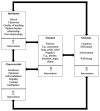Emotions and Instructed Language Learning: Proposing a Second Language Emotions and Positive Psychology Model
- PMID: 32982876
- PMCID: PMC7477346
- DOI: 10.3389/fpsyg.2020.02142
Emotions and Instructed Language Learning: Proposing a Second Language Emotions and Positive Psychology Model
Erratum in
-
Corrigendum: Emotions and Instructed Language Learning: Proposing a Second Language Emotions and Positive Psychology Model.Front Psychol. 2020 Nov 26;11:605188. doi: 10.3389/fpsyg.2020.605188. eCollection 2020. Front Psychol. 2020. PMID: 33324302 Free PMC article.
Abstract
Although emotion research and positive psychology (PP) have recently gained strong momentum in the field of second language acquisition (SLA), theoretical models linking language emotion and PP research, which offer insights for both research and intervention practice are lacking. To address this gap, the present article first introduces the origin, concept, and research around PP. Next, it summarizes recent research on PP and emotions in SLA. Finally, by triangulating emotion theories and research in the fields of psychology, education, and SLA, we propose a new model, which merges the three pillars of PP (positive institutions, positive characteristics, and positive emotions) with the antecedents, outcomes, and interventions of second language (L2) emotions (the L2EPP model). The value of the model to L2 pedagogy and research is highlighted in the context of the importance of integrating PP into the area of emotions and instructed SLA.
Keywords: emotion; learning; positive psychology; second language acquisition; teaching; theory.
Copyright © 2020 Shao, Nicholson, Kutuk and Lei.
Figures
Similar articles
-
Positioning an Agenda on a Loving Pedagogy in Second Language Acquisition: Conceptualization, Practice, and Research.Front Psychol. 2022 May 20;13:894190. doi: 10.3389/fpsyg.2022.894190. eCollection 2022. Front Psychol. 2022. PMID: 35668974 Free PMC article. Review.
-
Researching and Practicing Positive Psychology in Second/Foreign Language Learning and Teaching: The Past, Current Status and Future Directions.Front Psychol. 2021 Aug 19;12:731721. doi: 10.3389/fpsyg.2021.731721. eCollection 2021. Front Psychol. 2021. PMID: 34489835 Free PMC article. Review.
-
Corrigendum: Emotions and Instructed Language Learning: Proposing a Second Language Emotions and Positive Psychology Model.Front Psychol. 2020 Nov 26;11:605188. doi: 10.3389/fpsyg.2020.605188. eCollection 2020. Front Psychol. 2020. PMID: 33324302 Free PMC article.
-
Emotion-related theories in classroom language learning: the conceptualization and causation of emotions.Front Psychol. 2025 Feb 26;16:1551640. doi: 10.3389/fpsyg.2025.1551640. eCollection 2025. Front Psychol. 2025. PMID: 40083763 Free PMC article. Review.
-
Trait Emotional Intelligence and Classroom Emotions: A Positive Psychology Investigation and Intervention Among Chinese EFL Learners.Front Psychol. 2019 Oct 31;10:2453. doi: 10.3389/fpsyg.2019.02453. eCollection 2019. Front Psychol. 2019. PMID: 31736840 Free PMC article.
Cited by
-
A qualitative analysis of control-value appraisals, positive achievement emotions, and EFL performance in a Chinese senior high school context.Front Psychol. 2022 Sep 15;13:986684. doi: 10.3389/fpsyg.2022.986684. eCollection 2022. Front Psychol. 2022. PMID: 36186346 Free PMC article.
-
Exploring Chinese EFL Learners' Achievement Emotions and Their Antecedents in an Online English Learning Environment.Front Psychol. 2021 Oct 15;12:722622. doi: 10.3389/fpsyg.2021.722622. eCollection 2021. Front Psychol. 2021. PMID: 34721180 Free PMC article.
-
The relative importance of peace of mind, grit, and classroom environment in predicting willingness to communicate among learners in multi-ethnic regions: a latent dominance analysis.BMC Psychol. 2025 Apr 18;13(1):401. doi: 10.1186/s40359-025-02676-2. BMC Psychol. 2025. PMID: 40251638 Free PMC article.
-
Examining the relationship between perceived teacher support and students' academic engagement in foreign language learning: Enjoyment and boredom as mediators.Front Psychol. 2022 Sep 20;13:987554. doi: 10.3389/fpsyg.2022.987554. eCollection 2022. Front Psychol. 2022. PMID: 36204761 Free PMC article.
-
Are emotions contagious? A conceptual review of studies in language education.Front Psychol. 2022 Oct 21;13:1048105. doi: 10.3389/fpsyg.2022.1048105. eCollection 2022. Front Psychol. 2022. PMID: 36337507 Free PMC article. Review.
References
-
- Arens A. K., Morin A., Watermann R. (2015). Relations between classroom disciplinary problems and student motivation: achievement as a potential mediator? Learn. Instr. 39, 184–193. 10.1016/j.learninstruc.2015.07.001 - DOI
-
- Arnold J. (ed.) (1999). Affect in language learning. Cambridge: Cambridge University Press.
-
- Chow B. W., Chiu H. T., Wong S. W. (2018). Anxiety in reading and listening English as a foreign language in Chinese undergraduate students. Lang. Teach. Res. 22, 719–738. 10.1177/1362168817702159 - DOI
-
- Davari H., Karami H., Nourzadeh S., Iranmehr A. (2020). Examining the validity of the Achievement Emotions Questionnaire for measuring more emotions in the foreign language classroom. J. Multiling. Multicult. Dev. 10.1080/01434632.2020.1766054 [Epub ahead of print] - DOI
LinkOut - more resources
Full Text Sources
Miscellaneous


